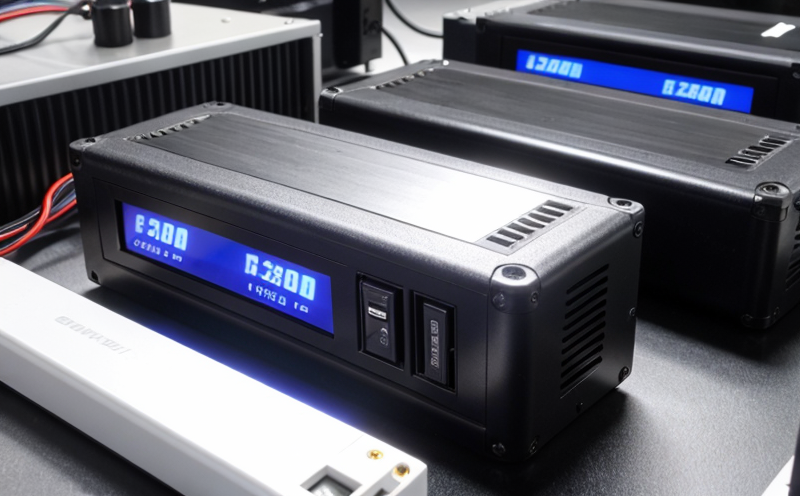IEC 62619 Industrial Lithium Battery Performance Testing
The IEC 62619 standard is a critical benchmark for ensuring the safety and performance of industrial lithium batteries. This standard covers various aspects, including performance characteristics, durability, and environmental stress testing. The testing regime outlined in this standard is designed to ensure that industrial batteries meet stringent requirements under real-world conditions.
When it comes to IEC 62619 compliance, the primary focus is on evaluating the battery's ability to maintain its operational integrity over extended periods of time and under various environmental stresses. This includes testing for temperature cycling, vibration resistance, and moisture exposure. These tests are essential in industries where reliability and safety are paramount, such as automotive, aerospace, and telecommunications.
The testing process begins with meticulous specimen preparation. Depending on the specific requirements of IEC 62619, this may involve conditioning the batteries to a specified state-of-charge (SOC) level or ensuring they meet certain dimensional specifications. Once prepared, the batteries undergo a series of tests that simulate the operational environment in which they will be used.
One of the key aspects of IEC 62619 testing is the evaluation of battery performance under different temperature conditions. This includes both high-temperature and low-temperature cycling to assess how well the battery retains its capacity over time. The standard also covers vibration tests, which are crucial for ensuring that batteries can withstand the mechanical stress encountered in transportation or industrial applications.
Moisture exposure testing is another critical component of IEC 62619 compliance. This test evaluates the battery's ability to maintain performance and integrity when exposed to moisture, which is particularly important for outdoor or marine environments. Additionally, the standard includes tests for mechanical integrity under pressure, ensuring that batteries can withstand the physical stresses they may encounter in use.
Another significant aspect of IEC 62619 testing is the evaluation of battery safety features. This involves assessing the performance of thermal management systems and overcurrent protection mechanisms to ensure that the battery operates safely within its design limits. The standard also includes tests for short-circuit current capacity, which is crucial for preventing potential hazards in industrial settings.
The results of IEC 62619 testing are typically reported in a comprehensive test report that details the performance metrics and any deviations from expected values. This report serves as a valuable tool for quality managers and compliance officers to ensure that the batteries meet all regulatory requirements and perform reliably under real-world conditions.
For R&D engineers, IEC 62619 testing provides critical insights into how different design parameters affect battery performance. By identifying areas where improvements can be made, these tests help drive innovation in lithium battery technology. For procurement professionals, compliance with this standard ensures that they are selecting batteries that meet the highest safety and performance standards.
The IEC 62619 standard is widely recognized for its comprehensive approach to evaluating industrial lithium batteries. Its acceptance by major global markets, including Europe, North America, and Asia, underscores its importance in ensuring consistent quality across international boundaries.
Industry Applications
The IEC 62619 standard is particularly relevant for industries where the reliability of lithium batteries is critical. These include automotive manufacturing, aerospace engineering, telecommunications infrastructure, and renewable energy systems. In the automotive sector, ensuring that lithium batteries meet the stringent requirements of IEC 62619 is crucial for maintaining vehicle safety and performance.
In aerospace applications, the ability to withstand extreme environmental conditions makes IEC 62619 compliance essential. The standard helps ensure that batteries can operate reliably in high-altitude environments or under harsh weather conditions. For telecommunications infrastructure, lithium batteries play a vital role in providing uninterrupted power supply. Compliance with IEC 62619 ensures that these systems remain operational during critical situations.
In renewable energy systems, the storage capabilities of lithium batteries are increasingly important for balancing grid loads and supporting sustainable energy solutions. The robustness and reliability provided by IEC 62619 testing ensure that these batteries can meet the demanding requirements of this sector.
International Acceptance and Recognition
The international acceptance and recognition of the IEC 62619 standard is a testament to its importance in ensuring consistent quality across global markets. This standard has been adopted by countries around the world, including those that are members of the International Electrotechnical Commission (IEC).
- Europe: The European Union recognizes the IEC 62619 standard as essential for ensuring the safety and performance of industrial lithium batteries.
- North America: In North American markets, compliance with this standard is crucial for manufacturers looking to export products globally.
- Asia-Pacific: Countries in the Asia-Pacific region also recognize the importance of IEC 62619 for maintaining consistent quality standards across international boundaries.
The widespread adoption of this standard highlights its role as a benchmark for industrial lithium battery performance. By adhering to these stringent testing criteria, manufacturers can ensure that their products meet the highest safety and performance standards recognized internationally.





